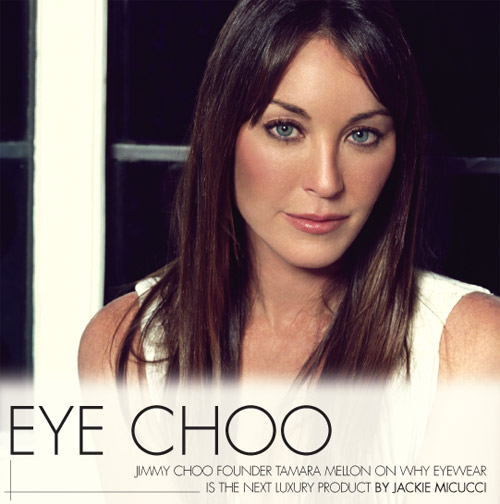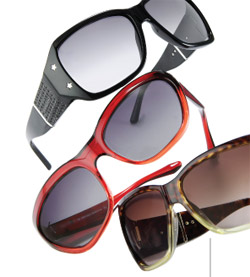
“It doesn’t matter what you are wearing—if you have good shoes and a good bag, you’ll look right.” So says Tamara Mellon, president and founder of Jimmy Choo, the wildly popular luxury footwear and handbag brand. Now add eyewear and sunwear to the above quote.
The Jimmy Choo company released both their first ophthalmic and sunwear collections for Spring/Summer 2008 with Sàfilo USA. It was a natural progression for the company, notes Mellon from her London offices. “My vision from the beginning was to accessorize women completely,” she says. “After shoes and bags, sunglasses and eyewear are the most organic steps—even before jewelry and swimwear. Sunglasses say so much about a woman, much like shoes and handbags. It’s the next statement item.”
The line is very much reflective of the Jimmy Choo image. “Any collection we do has to have the Jimmy Choo identity; it has to have the DNA of the brand,” explains Mellon. “It needs to sit on the right side of sexy. It needs to be chic and have the right sense of fun. For example, the sunwear has stars on the side and Swarovski crystal embellishments but in a very cool and chic way.” The eyewear also draws inspiration from the shoes and handbags and has unique cut-out temples with Jimmy Choo logos or signature hardware.
Working with a licensor can be tricky but Mellon has been very pleased with Jimmy Choo’s collaboration with Sàfilo. “They have been absolutely fantastic,” she says. “We are very, very proud of the product we created. It has incredible quality, which we’re really looking for, and really innovative design as well as good execution.”
The Jimmy Choo brand was launched in 1996 when Mellon, then accessories editor for Vogue UK, sensed a demand for stylish but wearable shoes. The London-born Mellon knew a thing or two about fashion thanks to her mother, Ann Yeardye, a former Chanel model, and her father, Tom Yeardye, co-founder of the Vidal Sassoon hair care empire.
Mellon approached Jimmy Choo, a couture shoe-maker based in the East End of London known for his outstanding craftsmanship, to help bring her vision to life. Choo, who worked in virtual obscurity from his non-descript shop, was a darling of the rich and famous in the know, including Princess Diana. Mellon soon secured funding for the creation of her business and sourced factories in Italy. In addition, she set up an Italian office to handle production, quality control and shipping. By 2001, Jimmy Choo had more than 100 wholesale clients including Saks Fifth Avenue, Bergdorf Goodman, Harrods and Harvey Nichols. In addition, Jimmy Choo has grown from its first boutique in London’s exclusive Knightsbridge in 1996 to over 65 stores including New York, Beverly Hills, Miami, Tokyo, Hong Kong, Paris and Milan.
 A favorite of celebrities, some of the household names that are aficionados of the brand include Jennifer Lopez, Katherine Heigl, Victoria Beckham, Jennifer Garner and Scarlett Johanssen. However, a good chunk of the brand’s popularity in the States is owed to Carrie Bradshaw… writer Candace Bushnell’s doppelganger and later Sarah Jessica Parker’s character in the über popular New York Observer column-turned-HBO-series-turned-movie “Sex & The City.”
A favorite of celebrities, some of the household names that are aficionados of the brand include Jennifer Lopez, Katherine Heigl, Victoria Beckham, Jennifer Garner and Scarlett Johanssen. However, a good chunk of the brand’s popularity in the States is owed to Carrie Bradshaw… writer Candace Bushnell’s doppelganger and later Sarah Jessica Parker’s character in the über popular New York Observer column-turned-HBO-series-turned-movie “Sex & The City.”
But because most women do not dress like the SATC posse, Mellon says one way that women can achieve status is through luxury accessories. “The world has become so much more casual,” she notes. “We all wear jeans every day. Women now get their status from handbags, shoes and sunglasses.”
It’s vital, adds Mellon, to keep the brand current, which is achieved through a combination of unique and classic design. “The most important thing for a luxury brand is innovative design,” she says. “Without that a luxury brand will die. It’s also important to keep our iconic products. They are timeless and look beautiful. We still have a customer for that. However, we also have to have continuous innovation and exclusivity.”
Mellon is very hands-on with Jimmy Choo. She oversees all the collections, whether it’s handbags, shoes or eyewear. “They all have to be legitimate and make sense to the brand,” she explains. “It has to reflect the identity of the brand. This way a woman can come into the shop and buy shoes, a bag and sunglasses. We can accessorize her almost completely. We don’t want to go too far or too way out from the core product. It has to be legitimate and true to the name.”
There are two parts to the brand, she explains. “There is the classic Jimmy Choo and the really fashion-forward Jimmy Choo. The classic is part of our day groups—you see the more classic heel and last on the shoe. It stays with a skinnier heel and pointy toe. It’s a beautiful toe. It’s a beautiful timeless look. Of course, the classic was very fashion forward when it was introduced. Today the trend is a more sky scraper high heel or crazy wedges. But the brand has always been leading.”
Mellon turns to a variety of sources for inspiration when putting together the brand’s various collections. “It can really come from anything,” she says. “A lot comes from travel. We may take an inspiration trip to India and shop for jewelry in Jaipur; we may look at vintage pieces or look through old magazines. It can come from architecture or music. Then we put it all on inspiration boards.”
So what lies on the horizon for Jimmy Choo? “I want to keep accessorizing women,” says Mellon. “I can see us doing swimwear. We get asked a lot to do children’s shoes. Jewelry, furs and watches all make sense for the brand.”
Tamara Mellon is well aware of her role as an arbiter of style. She takes that position seriously and maintains she wouldn’t include anything in the Jimmy Choo collection that she herself wouldn’t wear. “Jimmy Choo always reflects my own personal sense of style,” she says. “It’s all things I would want in my own closet. I have to have an emotional connection with the product. It’s my point-of-view.” …A view that many fashionable women have come to embrace.











